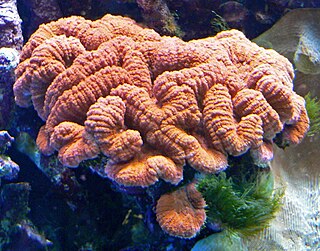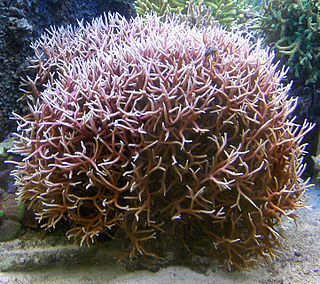
Lobophyllia hemprichii, commonly called lobed brain coral, lobed cactus coral or largebrain root coral, is a species of large polyp stony coral in the family Lobophylliidae. It is found in the Indo-Pacific Ocean. In its specific name Christian Gottfried Ehrenberg honoured his late partner the Prussian naturalist Wilhelm Hemprich; they were among the first to study the marine life of the Red Sea.

Diploastrea heliopora, commonly known as diploastrea brain coral or honeycomb coral among other vernacular names, is a species of hard coral in the family Diploastreidae. It is the only extant species in its genus. This species can form massive dome-shaped colonies of great size.

Acropora millepora is a species of branching stony coral native to the western Indo-Pacific where it is found in shallow water from the east coast of Africa to the coasts of Japan and Australia.

Acropora microphthalma is a species of acroporid coral found in the Red Sea, the Gulf of Aden, the southwest and northern Indian Ocean, the central Indo-Pacific, Australia, Southeast Asia, Japan, the East China Sea and the oceanic west and central Pacific Ocean. It is also found in the Line Islands. It occurs in shallow tropical reefs on upper reef slopes, in turbid water and in sandy lagoons. It can be found from depths of 5–25 m.

The branch coral is a species of acroporid coral found in the southwest and northern Indian Ocean, the central Indo-Pacific, Australia, Southeast Asia, Japan and the East China Sea, Cook Islands and the oceanic west Pacific Ocean. It can be found in shallow reefs on the reef tops, walls and slopes to depths of 30 m.

Turbinaria is a genus of colonial stony corals in the family Dendrophylliidae. Common names for this genus include disc coral, scroll coral, cup coral, vase coral, pagoda coral and ruffled ridge coral. These corals are native to the Red Sea, Indian Ocean, Japan and the south Central Pacific Ocean.

Turbinaria reniformis, commonly known as yellow scroll coral, is a species of colonial stony coral in the family Dendrophylliidae. It is native to the Indo-Pacific region. The International Union for Conservation of Nature has rated its conservation status as being "vulnerable".

Turbinaria stellulata, also known as disc coral, is a species of colonial stony coral in the family Dendrophylliidae. It is native to the Indo-Pacific region. The International Union for Conservation of Nature has rated its conservation status as being "vulnerable".

Turbinaria mesenterina, commonly known as disc coral, is a species of colonial stony coral in the family Dendrophylliidae. It is native to the Indo-Pacific region. The International Union for Conservation of Nature has rated its conservation status as being "vulnerable".

Turbinaria peltata, commonly known as disc coral, is a species of colonial stony coral in the family Dendrophylliidae. It is native to the Indo-Pacific region. The International Union for Conservation of Nature has rated its conservation status as being "vulnerable".

Turbinaria bifrons, commonly known as disc coral, is a species of colonial stony coral in the family Dendrophylliidae. It is native to the Indo-Pacific region. It is a zooxanthellate coral that houses symbiont dinoflagellates in its tissues. This is an uncommon species and the International Union for Conservation of Nature has rated its conservation status as being "vulnerable".

Turbinaria frondens, commonly known as disc coral, is a species of colonial stony coral in the family Dendrophylliidae. It is native to the Indo-Pacific region. It is a zooxanthellate coral that houses symbiont dinoflagellates in its tissues.
Turbinaria conspicua, commonly known as disc coral, is a species of colonial a stony coral in the family Dendrophylliidae. Found abundant in the eastern Indian Ocean and the western Pacific region, including Indonesia, Papua New Guinea and northern Australia. It is a zooxanthellaa coral that houses symbiont dinoflagellates in its tissues. It was studied by Bernard in 1896 and he rated it as a least concern species by the International Union for Conservation of Nature (IUCN).
Turbinaria radicalis, also known as disc coral, is a species of colonial stony coral in the family Dendrophylliidae. It is native to the central Indo-Pacific, tropical and sub-tropical Australia, the South China Sea, northern Australia and the West Pacific. It is a zooxanthellate coral that houses symbiont dinoflagellates in its tissues. It is a rare coral throughout its range and the International Union for Conservation of Nature has rated its conservation status as being "near-threatened".
Turbinaria heronensis, commonly known as disc coral, is a species of colonial stony coral in the family Dendrophylliidae. It is native to the Indo-Pacific region where it occurs in shallow water in Indonesia, Malaysia, Papua New Guinea, Fiji, the Philippines and Australia. It is a zooxanthellate coral that houses symbiont dinoflagellates in its tissues. It is an uncommon species and the International Union for Conservation of Nature (IUCN) has rated it as "vulnerable". It was described by Wells in 1958.
Turbinaria patula, commonly known as disc coral, is a species of colonial stony coral in the family Dendrophylliidae. It is native to the Indo-Pacific region, being found in the eastern Indian Ocean, northern Australia, the South China Sea and the western Pacific Ocean. It is a zooxanthellate coral that houses symbiont dinoflagellates in its tissues. It is an uncommon species and the International Union for Conservation of Nature (IUCN) has rated it as a "vulnerable" species.

Seriatopora hystrix is a species of colonial stony coral in the family Pocilloporidae. It forms a branching clump and is commonly known as thin birdsnest coral. It grows in shallow water on fore-reef slopes or in sheltered lagoons, the type locality being the Red Sea. It is native to East Africa, the Red Sea and the western Indo-Pacific region. It is a common species and the International Union for Conservation of Nature has assessed its conservation status as being of "least concern".
Seriatopora aculeata is a species of colonial stony coral in the family Pocilloporidae. It forms a bushy clump. It is native to the Central Indo-Pacific and the Oceanic West Pacific. Its range includes the Philippines, the Great Barrier Reef, Fiji, Indonesia, the Coral Sea, southern Madagascar and Vanuatu. It grows in shallow reef environments, at depths down to about 40 metres (130 ft). It is an uncommon species and subject to coral diseases and bleaching. The International Union for Conservation of Nature has assessed the conservation status of this species as being "vulnerable".

Oulophyllia crispa, sometimes called the intermediate valley coral, is a species of stony coral in the family Merulinidae. It is native to the tropical western and central Indo-Pacific region. Although this coral has a wide range, it is generally uncommon and seems to be decreasing in abundance, and the International Union for Conservation of Nature has rated its conservation status as being "near threatened".

Astreopora listeri is a species of hard coral found in shallow water in the tropical Indian and Pacific Oceans. It is an uncommon species with a wide range and is tolerant of turbid water, making it more resilient than some other corals to habitat disturbance. The International Union for Conservation of Nature has assessed its conservation status as being of "least concern".
















